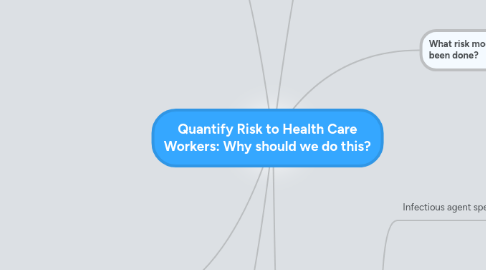
1. Reasons for NOT completing this effort? [NOTE - the Green dot is a mitigating factor for the negative statement and provides overall support for the effort]
1.1. Why not just maximally protect HCWs?
1.1.1. For respiratory protection, have them all wear N95s all the time.
1.1.1.1. PROS
1.1.1.1.1. They are not expensive
1.1.1.2. CONS
1.1.1.2.1. They are not well received by HCWs
1.1.1.2.2. A shortage is expected so you still need some planning to account for a shortage
1.1.1.2.3. May not be possible to fit test everyone during an emergency and other alternatives may be needed
1.1.1.2.4. N95 may not provide enough protection for all threats
1.1.1.2.5. HCWs can't wear N95 for long periods of time, especially when workload is heavy
1.1.2. Buy elastomeric respirators for HCWs
1.1.2.1. Need to be able to decon elastomerics quickly and effectively between patients
1.1.2.2. Cost becomes an issue
1.1.3. Facility Engineering controls are also included in this, which is cost prohibitive solution for most health care facilities
1.2. What does this refer to beyond respiratory protection?
1.2.1. Could have shortages of other supplies
1.2.1.1. Gloves
1.2.1.2. Gowns
1.2.1.3. Hand soap
1.2.1.4. Disinfectant
1.2.2. Certain high risk procedures or activities
1.2.2.1. OSHA had already declared many procedures high risk and called for higher levels of PPE
1.2.2.1.1. Not sure there was an actual risk analysis done
1.2.3. Quarantine procedures
2. How will government agencies benefit from this effort?
2.1. CDC
2.1.1. Allow decisions during a pandemic to be based on risk analysis.
2.1.2. Affect the way they manage the FFR strategic national stock pile
2.2. FDA
2.3. OSHA
2.3.1. There mission is to protect workers. The model provides risk based desision making.
2.4. NIOSH
2.5. BARDA
2.5.1. Drive their research mission
3. Empirical Model Components: I wasn't sure what to call this, but I am looking for specifics about different modeling capabilities and how they can be used in relation to the model input data.
4. Why is this important?
4.1. Ensure the safety of HCW during infectious outbreak scenarios
4.2. Understand the overall risk factors
4.3. Lead to the appropriate levels of protection
4.3.1. PPE
4.3.2. Engineering controls
4.4. Justify cost for protection. May even lead to reduced costs
4.4.1. Over protection is not good.
4.4.1.1. Lead to poor performance due to hindersome PPE
4.4.1.2. Waste full $$$
4.4.1.3. Leads to other unnecessary programs to support the original hindersome programs
4.4.1.4. Unnecessary operational procedures
4.4.2. Under protection is not good
4.4.2.1. Leads to infection of HCW
4.4.2.2. Leads to HCW not showing up for work
4.5. Drive preparedness planning
4.5.1. Scenario modeling should drive resource allocation
4.6. Provide HCW with a better understanding of why procedures are being implemented and may improve compliance.
4.6.1. Most helpful to HCW = education and training on respiratory protection which could include tangible risk values provided by model
4.6.1.1. Most fit-testers know little to nothing about respiratory protection other than how to perform the fit-test
4.7. Prevents preparing for the worst case scenario
4.8. Lead to and justify the need for new research to fill data gaps.
4.9. Allow allocation of resources to meet the challenges of a particular emegency
5. What risk modeling or analysis has already been done?
5.1. Andy Levinson indicated he was not aware of any modeling like this that has been done.
5.2. Dr. Nicas has done some work in this area that could be very useful
5.3. Hospitals have planning guides now that must be based on some data or relevant information
6. Model Inputs
6.1. Infectious agent specifics
6.1.1. Genus, species, strain identification
6.1.2. Estimated particle size
6.1.3. Morbidty of the specific strain
6.1.3.1. Function of amounts ingested (not well known)
6.1.3.2. Function of individual susceptibilities (age, workload, time of year, general health; may even out statistically)
6.1.4. Mortality of the specific strain
6.1.4.1. Same as morbidity
6.1.5. What is currently known about mode of transmission
6.1.6. Estimated Aerosol concentration
6.2. Facility Engineering Controls
6.2.1. Air exchanges per hour
6.2.2. Air decontamination units (UV light or other)
6.2.3. Age and size of facility
6.3. Personnel Considerations
6.3.1. Respiratory protection program
6.3.2. Inspection records
6.3.3. Staff HAI infection rate history
6.3.4. Vaccination policy
6.3.5. Handwash compliance
6.3.6. Training programs
6.3.7. Compliance records
6.4. Facility Prepardness Activities
6.4.1. Stock piling of supplies
6.4.1.1. N95s
6.4.1.2. surgical masks
6.4.1.3. gloves
6.4.2. Access to regional, state, and federal stockpiles
6.4.3. Surge planning
6.4.4. Plans to partition patient streams with symptoms from the general population
